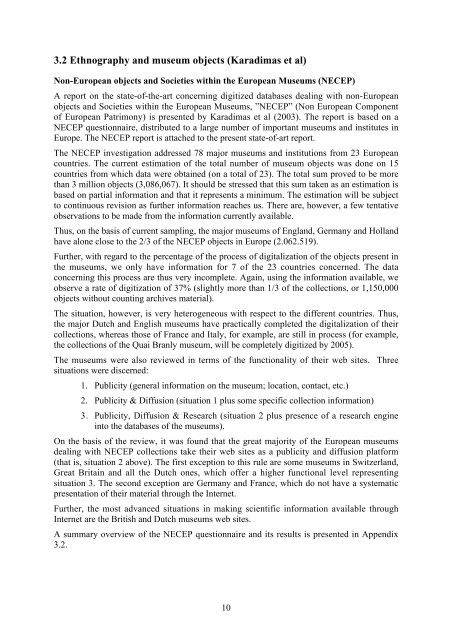European Cultural Heritage Online - ECHO
European Cultural Heritage Online - ECHO
European Cultural Heritage Online - ECHO
You also want an ePaper? Increase the reach of your titles
YUMPU automatically turns print PDFs into web optimized ePapers that Google loves.
3.2 Ethnography and museum objects (Karadimas et al)Non-<strong>European</strong> objects and Societies within the <strong>European</strong> Museums (NECEP)A report on the state-of-the-art concerning digitized databases dealing with non-<strong>European</strong>objects and Societies within the <strong>European</strong> Museums, ”NECEP” (Non <strong>European</strong> Componentof <strong>European</strong> Patrimony) is presented by Karadimas et al (2003). The report is based on aNECEP questionnaire, distributed to a large number of important museums and institutes inEurope. The NECEP report is attached to the present state-of-art report.The NECEP investigation addressed 78 major museums and institutions from 23 <strong>European</strong>countries. The current estimation of the total number of museum objects was done on 15countries from which data were obtained (on a total of 23). The total sum proved to be morethan 3 million objects (3,086,067). It should be stressed that this sum taken as an estimation isbased on partial information and that it represents a minimum. The estimation will be subjectto continuous revision as further information reaches us. There are, however, a few tentativeobservations to be made from the information currently available.Thus, on the basis of current sampling, the major museums of England, Germany and Hollandhave alone close to the 2/3 of the NECEP objects in Europe (2.062.519).Further, with regard to the percentage of the process of digitalization of the objects present inthe museums, we only have information for 7 of the 23 countries concerned. The dataconcerning this process are thus very incomplete. Again, using the information available, weobserve a rate of digitization of 37% (slightly more than 1/3 of the collections, or 1,150,000objects without counting archives material).The situation, however, is very heterogeneous with respect to the different countries. Thus,the major Dutch and English museums have practically completed the digitalization of theircollections, whereas those of France and Italy, for example, are still in process (for example,the collections of the Quai Branly museum, will be completely digitized by 2005).The museums were also reviewed in terms of the functionality of their web sites. Threesituations were discerned:1. Publicity (general information on the museum; location, contact, etc.)2. Publicity & Diffusion (situation 1 plus some specific collection information)3. Publicity, Diffusion & Research (situation 2 plus presence of a research engineinto the databases of the museums).On the basis of the review, it was found that the great majority of the <strong>European</strong> museumsdealing with NECEP collections take their web sites as a publicity and diffusion platform(that is, situation 2 above). The first exception to this rule are some museums in Switzerland,Great Britain and all the Dutch ones, which offer a higher functional level representingsituation 3. The second exception are Germany and France, which do not have a systematicpresentation of their material through the Internet.Further, the most advanced situations in making scientific information available throughInternet are the British and Dutch museums web sites.A summary overview of the NECEP questionnaire and its results is presented in Appendix3.2.10


